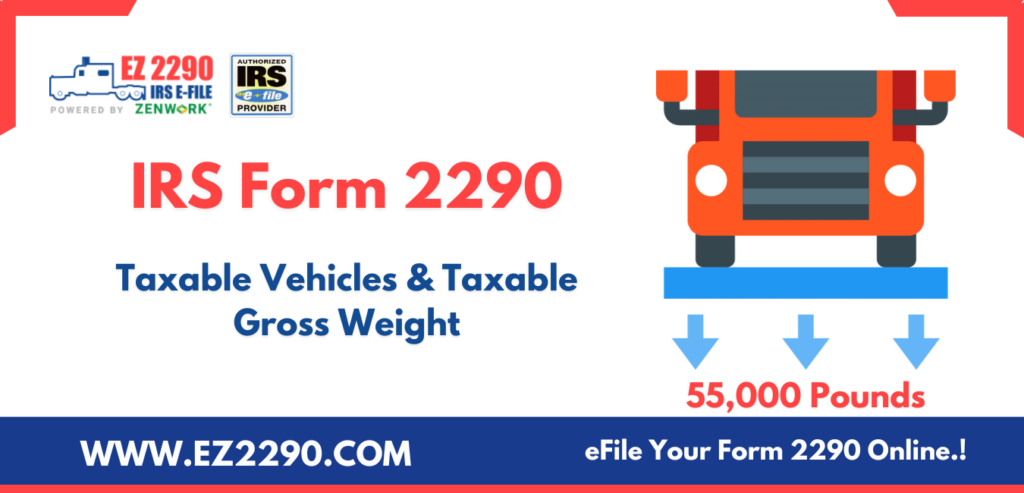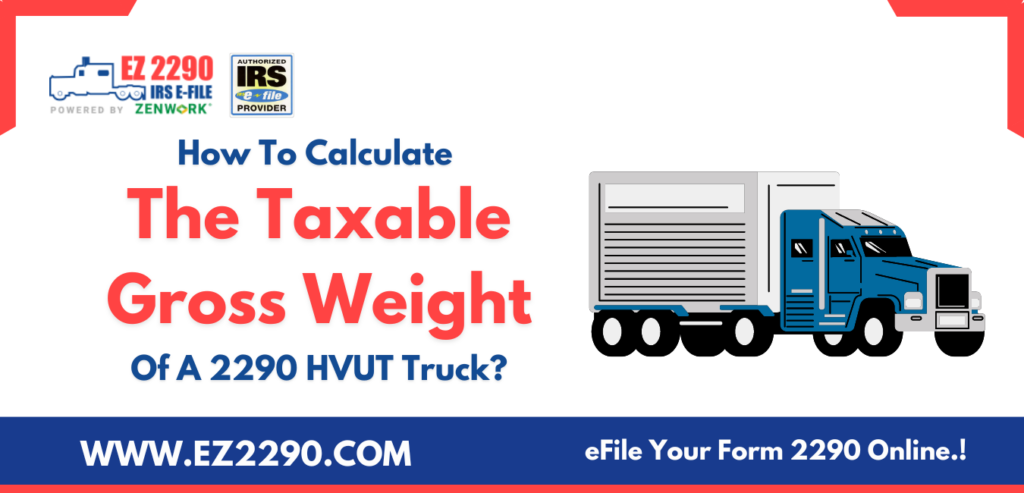

Filing Form 2290 for your vehicle may initially seem like a complicated process. But as you start understanding the details, it can be pretty easy and simple. Let’s begin with Form 2290 or the heavy vehicle use tax (HVUT). Form 2290 is a type of tax levied on heavy motor vehicles operating on public highways with a registered gross weight of or more than 55,000 pounds.
The IRS defines a highway motor vehicle as “any self-propelled vehicle designed to carry a load over public highways, whether or not also designed to perform other functions.” Some of the examples of heavy motor vehicles are trucks, truck tractors, and buses, while smaller vehicles like vans and pickup trucks are exempt from this tax as they have a taxable gross weight of less than 55,000 pounds.
So, how do we calculate the gross weight of a vehicle? The first step would be determining the category of your vehicle. The vehicles are categorized as logging vehicles and non-logging vehicles. The tax amount for both varies based on their respective weights but logging vehicles are taxed at comparatively reduced rates. You can find the vehicle category and tax rates here.
Things to Keep in Mind Before Calculating Gross Weight of Vehicle
After determining the vehicle category, here are a few things to keep in mind before calculating the gross weight of the vehicle:
- The taxable gross weight of a vehicle is the total of:
- the actual unloaded weight of the vehicle (empty weight of the vehicle) that is fully equipped for service.
- the actual unloaded weight of any trailers or semitrailers fully equipped for service that are to be used in combination with the vehicle.
- the weight of the maximum load typically carried on the vehicle and on any trailers or semitrailers typically used in combination with the vehicle.
- A vehicle which is fully equipped for service includes the body (irrespective of whether it is designed to transport cargo or not) along with all accessories and equipment attached to or carried on the vehicle for use in its operation or maintenance, and a full supply of fuel, oil, and water.
- The taxable gross weight of a bus is its actual unloaded weight after it is fully equipped for service and an addition of 150 pounds for each seat provided for passengers and driver.
- For buses, fully equipped for service includes the equipment for the accommodation of passengers or others (e.g., air conditioning equipment and sanitation facilities, etc.). This excludes the driver and any equipment mounted on or attached to the vehicle for handling, protecting, or preserving cargo; or any special equipment (e.g., air compressor, crane, etc.).
Categories for State Registration by Weight
The weight declared for registering a vehicle in a state may affect the taxable gross weight used to calculate the tax.
The categories for state registration by weight are as follows:
- State Registration by Specific Gross Weight: If your state requires registration by specific gross weight, you must provide the DMV with the exact weight of your vehicle, including any attachments or equipment. This weight is used to determine the registration fee for your vehicle. To calculate your taxable gross weight, add the vehicle’s unloaded weight to the maximum load weight it can carry.
- State registration by gross weight category: Some states have registration categories based on gross weight ranges. You must determine your vehicle’s category and provide that information to the DMV. To calculate your taxable gross weight, add the vehicle’s unloaded weight to the maximum load weight it can carry and ensure that it falls under the correct weight category.
- State registration by actual unloaded weight: If your state requires registration by actual unloaded weight, you must provide the weight of your vehicle without any load or passengers. To calculate your taxable gross weight, add the vehicle’s unloaded weight to the maximum load weight it can carry.
Exemptions by Federal Government
Apart from the above conditions, the federal government has exempted certain vehicles from the HVUT:
- Commercial vehicles traveling less than 5,000 miles a year
- Agriculture vehicles traveling less than 7,500 miles a year
- Vehicle not considered highway motor vehicles — e.g., mobile machinery for non-transportation functions, vehicles specifically designed for off-highway transportation, and non-transportation trailers and semi-trailers
- Qualified blood collector vehicles used by qualified blood collector organizations
The use of a highway motor vehicle isn’t subject to the tax if it is used and actually operated by:
- The federal government
- The District of Columbia
- A state or local government
- The American National Red Cross
- A nonprofit volunteer fire department, ambulance association, or rescue squads
- An Indian tribal government but only if the vehicle’s use involves the exercise of an essential tribal government function
- A mass transportation authority if it is created under a statute that gives it certain powers normally exercised by the state.
Note that these entities may still be required to file tax forms with the IRS or notify the local DMV of the exempt status being claimed.
Now that you’ve understood how to calculate the taxable gross weight of your vehicle, let’s get to filing your Form 2290 before the August 31 deadline. EZ2290 makes the tax filing process as effortless as possible. All you need to do is create a free account, enter the required business and vehicle information, and voila! What’s more? We also provide the IRS Stamped Schedule-1 within minutes of your submission.
Let’s start filing now- File IRS Form 2290 Online
 1-877-811-ETAX
1-877-811-ETAX






